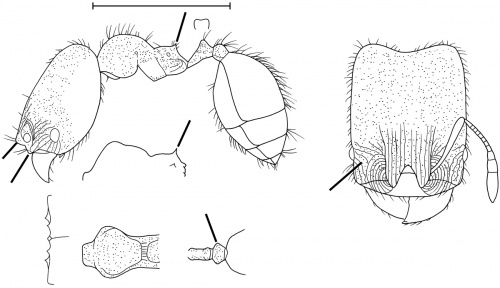Pheidole olsoni
| Pheidole olsoni | |
|---|---|

| |
| Scientific classification | |
| Kingdom: | Animalia |
| Phylum: | Arthropoda |
| Class: | Insecta |
| Order: | Hymenoptera |
| Family: | Formicidae |
| Subfamily: | Myrmicinae |
| Tribe: | Attini |
| Genus: | Pheidole |
| Species: | P. olsoni |
| Binomial name | |
| Pheidole olsoni Wilson, 2003 | |
The holotype was collected in rainforest at a tuna bait; the Chiriquí, Panama, specimens were found in a log. Males were present in the latter colony on 18 August. (Wilson 2003)
Identification
See the description in the nomenclature section.
Keys including this Species
Distribution
From Wilson (2003): Known from the type locality and from El Volcan, Chiriquí, Panama, 1280 m, col. L. Hare. (Wilson 2003)
Latitudinal Distribution Pattern
Latitudinal Range: 10.971° to 9.4817844°.
| North Temperate |
North Subtropical |
Tropical | South Subtropical |
South Temperate |
- Source: AntMaps
Distribution based on Regional Taxon Lists
Neotropical Region: Costa Rica (type locality), Guatemala, Honduras, Panama.
Distribution based on AntMaps
Distribution based on AntWeb specimens
Check data from AntWeb
Countries Occupied
| Number of countries occupied by this species based on AntWiki Regional Taxon Lists. In general, fewer countries occupied indicates a narrower range, while more countries indicates a more widespread species. |

|
Estimated Abundance
| Relative abundance based on number of AntMaps records per species (this species within the purple bar). Fewer records (to the left) indicates a less abundant/encountered species while more records (to the right) indicates more abundant/encountered species. |

|
Biology
Castes
 
| |
| . | |
This species is known from majors and males.
Nomenclature
The following information is derived from Barry Bolton's Online Catalogue of the Ants of the World.
- olsoni. Pheidole olsoni Wilson, 2003: 478, figs. (s.) COSTA RICA.
Unless otherwise noted the text for the remainder of this section is reported from the publication that includes the original description.
Description
DIAGNOSIS Known only from the major, easily distinguished by its very small size, elongated head, bicolorous body, protuberant frontal lobe in side view, small propodeal spine, cornulate postpetiole, and unusual pattern of the rugulae mesad to the eye, which travel downward (anteriorly) from the eye obliquely mesad to meet the circular carinulae of the antennal fossae.
Similar to Pheidole browni, Pheidole casta, Pheidole mera, Pheidole prolixa and Pheidole protensa, but easily separated by the above listed traits.
MEASUREMENTS (mm) Holotype major: HW 0.54, HL 0.74, SL 0.30, EL 0.08, PW 0.30.
COLOR Major: head, dorsum of alitrunk, petiolar node, and all of postpetiole medium brown; rest of body and all of appendages medium yellow.
Figure. Holotype, major. Scale bars = 1 mm.
Type Material
COSTA RICA: Refugio de Eladio, Peñas Blancas Valley, Alajuela, 780 m, col. David Olson. Museum of Comparative Zoology
Etymology
Named after the collector David Olson.
References
- Wilson, E. O. 2003. Pheidole in the New World: A dominant, hyperdiverse ant genus. Harvard University Press, Cambridge, MA. (page 478, fig. major described)
References based on Global Ant Biodiversity Informatics
- Fernández, F. and S. Sendoya. 2004. Lista de las hormigas neotropicales. Biota Colombiana Volume 5, Number 1.
- Longino J. T. L., and M. G. Branstetter. 2018. The truncated bell: an enigmatic but pervasive elevational diversity pattern in Middle American ants. Ecography 41: 1-12.
- Longino J. T., and R. K. Colwell. 2011. Density compensation, species composition, and richness of ants on a neotropical elevational gradient. Ecosphere 2(3): 16pp.
- Longino J. et al. ADMAC project. Accessed on March 24th 2017 at https://sites.google.com/site/admacsite/

